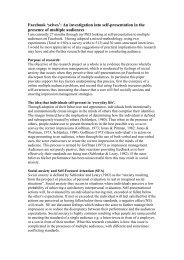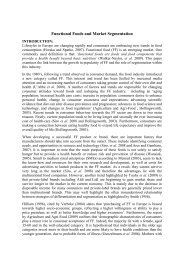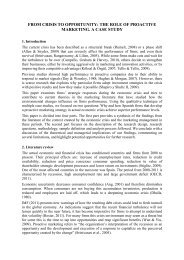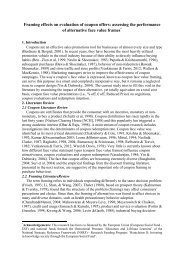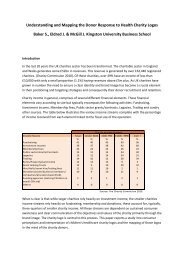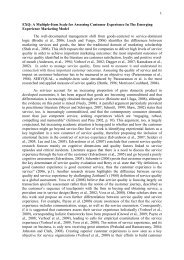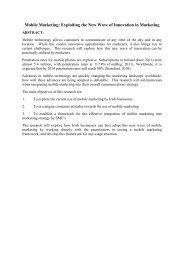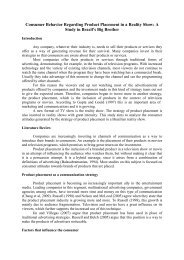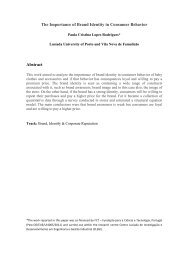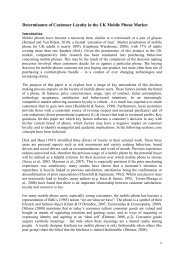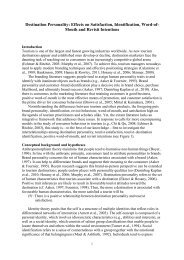The Vacation Lottery: Exploring the relationship between the ...
The Vacation Lottery: Exploring the relationship between the ...
The Vacation Lottery: Exploring the relationship between the ...
Create successful ePaper yourself
Turn your PDF publications into a flip-book with our unique Google optimized e-Paper software.
Travelling with Disabilities in a Digital Age<br />
Abstract<br />
Generally, advances within technology are applauded for providing greater access and<br />
engagement to consumers. <strong>The</strong>y are frequently reported as empowering us to<br />
participate, ei<strong>the</strong>r individually or collectively, in society, through affiliations and<br />
opportunities for self-expression. <strong>The</strong>re is an implicit assumption that we as a society<br />
are benefitting from <strong>the</strong>se advances. However, this paper challenges this line of<br />
thinking and argues instead that <strong>the</strong> <strong>relationship</strong> <strong>between</strong> consumption and technology<br />
is far more complicated than necessarily appreciated. Adopting qualitative research<br />
techniques this study examines <strong>the</strong> role of technology in <strong>the</strong> leisure travel of disabled<br />
travellers. General information regarding consumer engagement with technology (eg<br />
internet, e-mail, social media/social networking sites, smartphones etc) will be<br />
collected. Here both domestic and travel circumstances will be investigated. In <strong>the</strong><br />
leisure travel context each of <strong>the</strong> following actions: pricing; accessing medical<br />
assistance; accessing specially adapted facilities (eg transport, accommodation) will<br />
be explored and <strong>the</strong> enabling, or o<strong>the</strong>rwise, role of technology explored.
Travelling with Disabilities in a Digital Age<br />
Generally, advances within technology (eg internet, e-mail, social media/social<br />
networking sites, smartphones etc) are applauded for providing greater access and<br />
engagement to consumers. <strong>The</strong>y are frequently reported as empowering us to<br />
participate, ei<strong>the</strong>r individually or collectively, in society, through affiliations (eg<br />
social networking sites such as Facebook) and opportunities for self-expression (eg<br />
review websites) (Burton & Kammash, 2010; Litvin et al., 2008). <strong>The</strong>re is an implicit<br />
assumption that we as a society are benefitting from <strong>the</strong>se advances. Whe<strong>the</strong>r we are<br />
<strong>the</strong> ‘digital natives’ of Generation Y, Z and beyond, or <strong>the</strong> digital immigrants of<br />
previous generations (Prensky, 2001), technological advances are <strong>the</strong>re to facilitate<br />
and enhance our life experiences. However, this paper challenges this line of thinking<br />
and argues instead that <strong>the</strong> <strong>relationship</strong> <strong>between</strong> consumption and technology is far<br />
more complicated than necessarily appreciated. More specifically, <strong>the</strong> aim of <strong>the</strong><br />
paper is to explore <strong>the</strong> <strong>relationship</strong> by examining <strong>the</strong> leisure travel of disabled<br />
consumers from a technological perspective.<br />
Leisure travel is not accessible to all, with economic factors most commonly cited as<br />
a primary reason for constrained participation. Economic constraints represent only<br />
one part of <strong>the</strong> picture though with <strong>the</strong>ir contribution often over-simplified. Health<br />
and disability factors, at times <strong>the</strong> cause of economic hardship, be it short or longterm,<br />
are of at least equal significance yet remain infrequently considered. Such is<br />
particularly problematic given <strong>the</strong> capacity of <strong>the</strong>se factors to cut across <strong>the</strong> economic<br />
divide. <strong>The</strong> comment by Shaw and Coles (2004, p 399) that "few, if any of <strong>the</strong> social<br />
constructs of disability have permeated <strong>the</strong> tourism literature. <strong>The</strong>re has been a<br />
reluctance to explore <strong>the</strong> experiences of <strong>the</strong> disabled traveller, in addition to<br />
neglecting <strong>the</strong> wider <strong>relationship</strong> <strong>between</strong> disabled people and <strong>the</strong> tourism industry" is<br />
particularly pertinent to this paper as such criticism can equally be levied at our<br />
current understanding of <strong>the</strong> technological access and engagement of <strong>the</strong>se<br />
consumers. Consequently, <strong>the</strong> paper questions whe<strong>the</strong>r, and which forms of<br />
technology enhance tourism participation for disabled tourists today. Similarly it also<br />
questions which problems arise for associated consumers as a consequence of<br />
technological advances.<br />
Understanding <strong>the</strong> travel needs of <strong>the</strong> disabled community is complicated as only a<br />
narrow research agenda has been pursued to date. Three common areas of study exist.<br />
First, that which identifies <strong>the</strong> disabled community as a lucrative market segment<br />
waiting to be tapped. Second, that which considers <strong>the</strong> advantages of tourism<br />
participation for constrained consumers. Third, that which considers <strong>the</strong> constraints<br />
and barriers to participation <strong>the</strong> disabled community experiences.<br />
Investigating <strong>the</strong> <strong>relationship</strong> <strong>between</strong> tourism participation and serious illness,<br />
specifically cancer, Hunter-Jones (2004) identified <strong>the</strong> positive contribution of travel<br />
to wellbeing. Personal health, social effectiveness, personal identity and regaining<br />
independence were each identified as benefits of tourism participation. <strong>The</strong>se benefits<br />
are important and are generally reviewed within two contexts: physical benefits;<br />
psychological benefits. More broadly physical benefits have commonly been linked to<br />
active leisure participation. Gratton and Tice (1989) for instance contrasted<br />
participation with non-participation under four general headings namely health status,<br />
health attitudes, health lifestyles and leisure orientation. <strong>The</strong>y found <strong>the</strong>re to be a
growing body of medical evidence confirming that exercise improves health status<br />
and life expectancy. Exercise was shown to have its most positive effect on health in<br />
<strong>the</strong> prevention of coronary heart disease (CHD). Such observations are not new.<br />
Earlier empirical research completed by Morris et al. (1953) for example, established<br />
that bus conductors (spending most of <strong>the</strong> day walking up and downstairs on a bus<br />
collecting fares and rarely sitting down) were less at risk of having heart attacks than<br />
were sedentary bus drivers. Morris et al., (1980) followed up his study of London<br />
busmen with an analysis of <strong>the</strong> leisure-time activities of 17 944 middle-aged British<br />
Civil Servants. Those undertaking regular vigorous physical exercise were found to be at<br />
less than half <strong>the</strong> risk of experiencing CHD over <strong>the</strong> eight year follow up period than<br />
those who did no vigorous exercise.<br />
Commenting upon <strong>the</strong> perceived constraints of holiday spaces and places for disabled<br />
travellers, Shaw and Coles (2004, p. 401-402) concluded that "…out of <strong>the</strong> 24<br />
respondents in <strong>the</strong> case sample, only two had participated in overseas trips…<strong>the</strong><br />
impact of disability is to make some of <strong>the</strong> respondents very cautious in <strong>the</strong>ir choice<br />
of destinations". How far, and in what ways, technology may contribute to this<br />
disengagement is not clear, although <strong>the</strong>re is a literature which suggests <strong>the</strong>re to be a<br />
link. Questioning whe<strong>the</strong>r technological advancements have prompted <strong>the</strong><br />
emancipation or oppression of disabled people Sheldon (2009) for instance argues:<br />
“Disabled people have long been denied access to <strong>the</strong> technology that o<strong>the</strong>rs<br />
take for granted, and <strong>the</strong>re is little evidence that this exclusion is dissipating.<br />
Despite this, <strong>the</strong> issue of access to technology is often obscured because of <strong>the</strong><br />
undue emphasis placed on its potential for improving disabled people’s lot.<br />
This is a particular concern since a new form of social segmentation is<br />
predicted <strong>between</strong> those with and without access to <strong>the</strong> new systems”.<br />
(Sheldon, 2009, p. 157).<br />
This presentation will consider <strong>the</strong> pilot study findings of a qualitative study which<br />
examines <strong>the</strong> leisure travel of disabled travellers, questioning specifically <strong>the</strong> role<br />
technology plays within <strong>the</strong> process. General information regarding consumer<br />
engagement with technology will be reported. Here both domestic and travel<br />
circumstances will be investigated. In <strong>the</strong> leisure travel context each of <strong>the</strong> following<br />
actions: pricing; accessing medical assistance; accessing specially adapted facilities<br />
(eg transport, accommodation) will be explored and <strong>the</strong> enabling, or o<strong>the</strong>rwise, role of<br />
technology explored.
References<br />
Burton, J. & Kammash, M. (2010). Why do people read reviews posted on consumeropinion<br />
portals? Journal of Marketing Management, 26 (3-4), 230-255.<br />
Gratton, C. and Tice, A. (1989). Sports participation and health. Leisure Studies, 8<br />
(1), 77-92.<br />
Hunter-Jones, P. (2004). Young People, holiday-taking and cancer: an exploratory<br />
analysis. Tourism Management, 25 (2), 249-258.<br />
Litvin, S.W., Goldsmith, R.E. & Pan, B. (2008). Electronic word-of-mouth in<br />
hospitality and tourism management. Tourism Management, 29 (3), 458-468.<br />
Morris, J.N., Heady, J.A., Raffle, P.A.B., Roberts, C.G. & Parks, J.W. (1953).<br />
Coronary Heart Disease and Physical Activity of Work. Lancet, 2 (1053-1057), 1111-<br />
20.<br />
Morris, J.N. Evveritt, M.G., Pollard, R. Chave, S.P. & Semmence, A.M. (1980).<br />
Vigorous Exercise in Leisure Time: Protection against Coronary Heart Disease.<br />
Lancet, 2, 1207-10.<br />
Prensky, M. (2001). Digital Natives, Digital Immigrants. On <strong>the</strong> Horizon, 9 (5).<br />
Shaw, G. and Coles, T. (2004). Disability, holiday-making and <strong>the</strong> tourism industry: a<br />
preliminary survey. Tourism Management, 25 (3), 397-403.<br />
Sheldon, A. (2009) Changing Technology In Swain, J., French, S., Barnes, C. &<br />
Thomas, C. (eds.) Disabling Barriers – Enabling Environments, London: Sage, 155-<br />
160.



